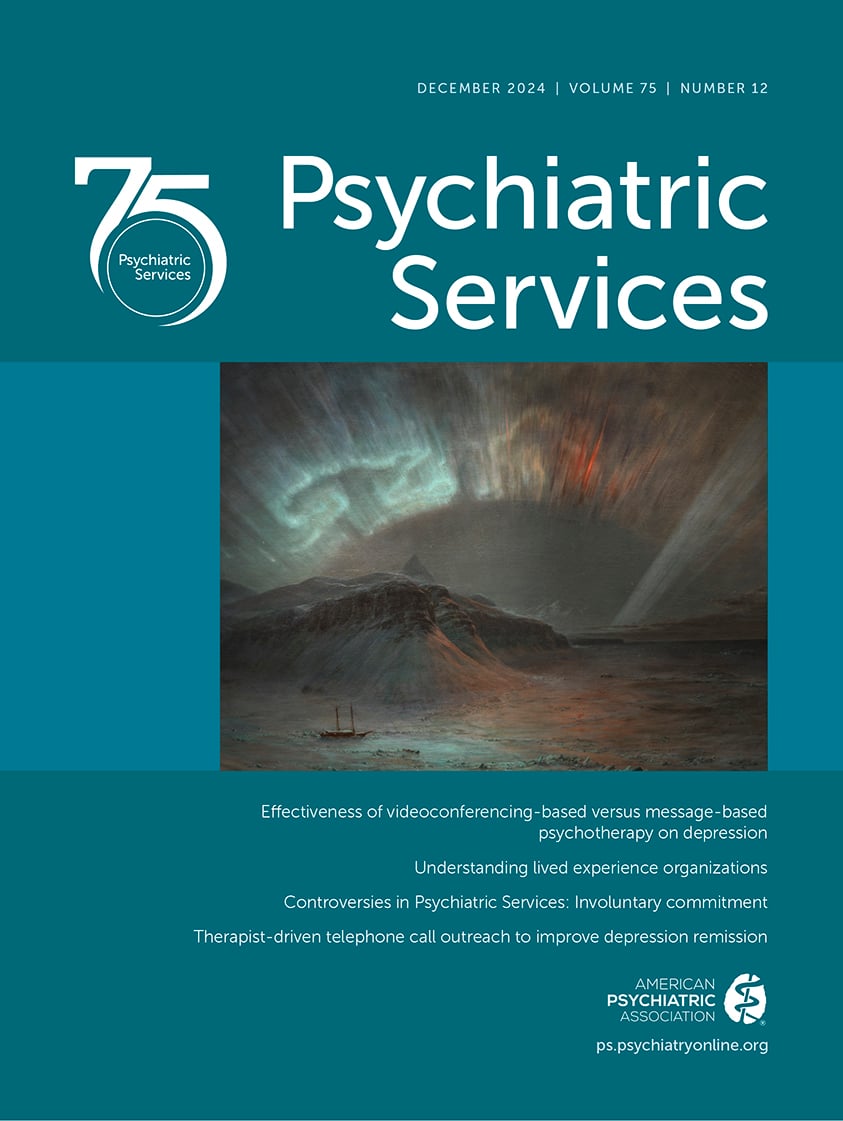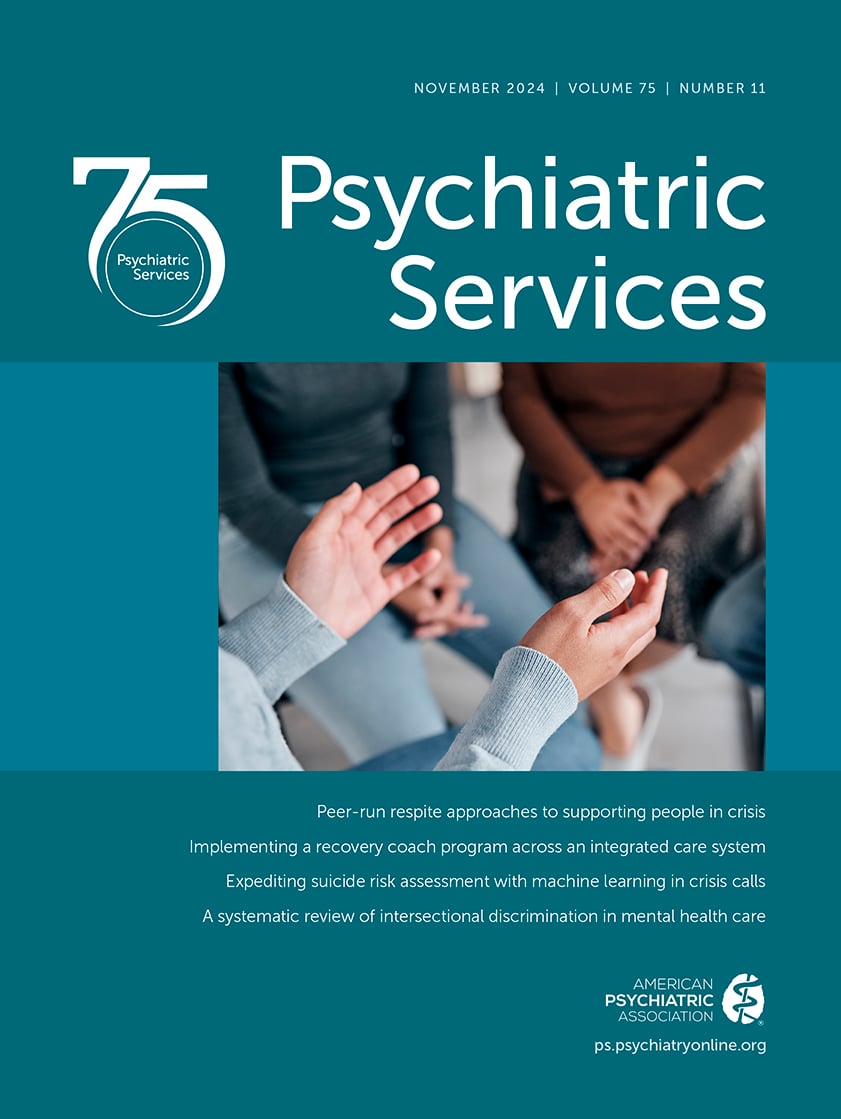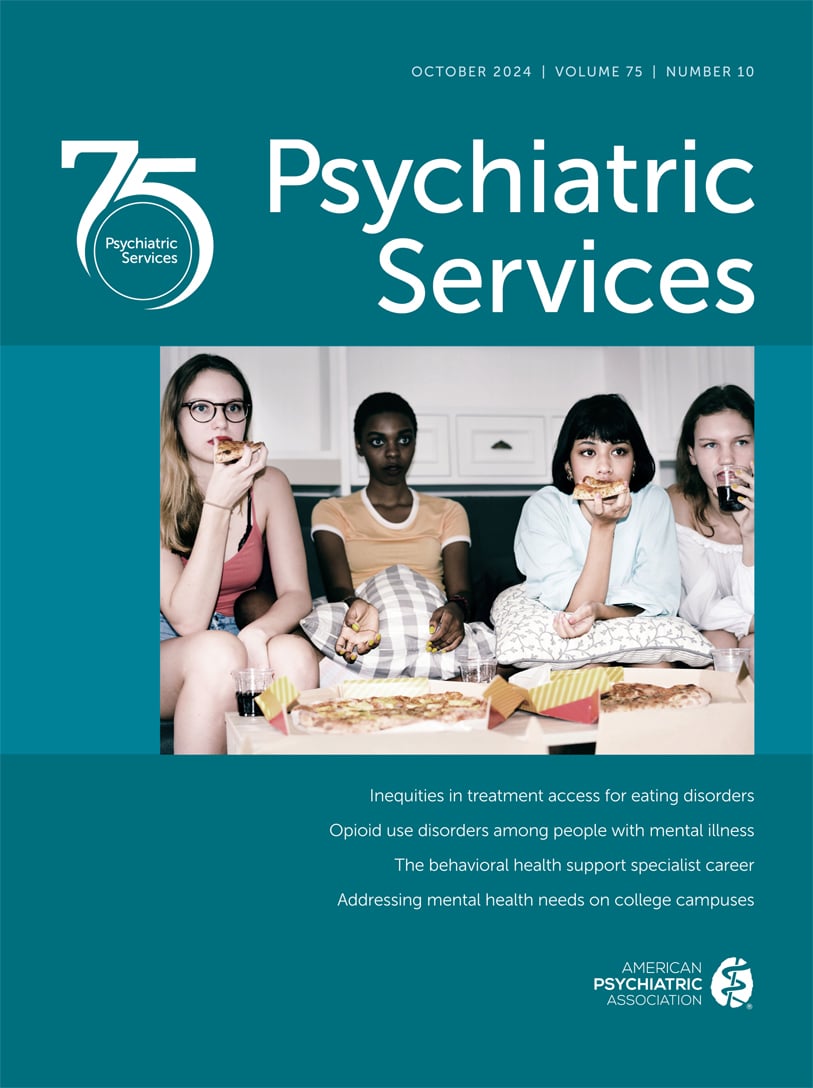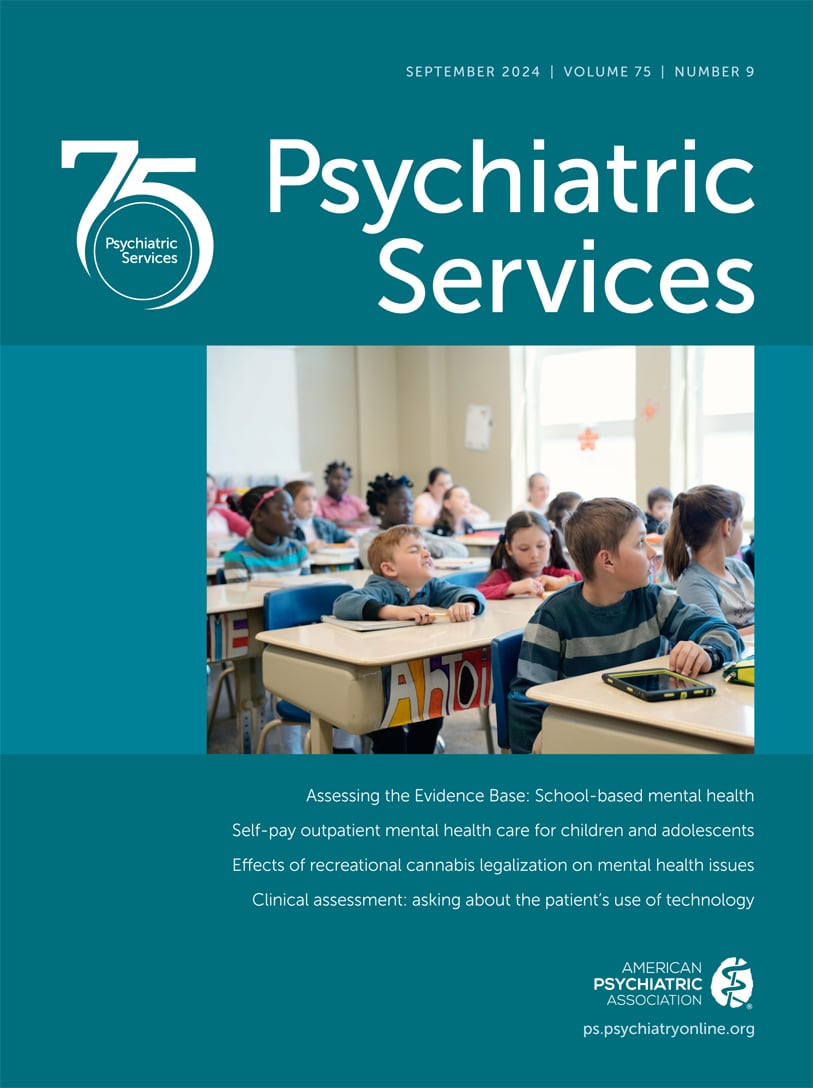Psychiatric Services
- Volume 70
- Number 10
- October 2019
TAKING ISSUE
Viewpoint
Articles
Publication date: 16 July 2019
Pages860–866Objective: Involving family in the care of inpatients with serious mental illness is known to be beneficial. This study examined frequencies of involvement by family in the care and discharge planning for 179 psychiatric inpatients. Methods: Involvement by ...
https://doi.org/10.1176/appi.ps.201900028Publication date: 24 July 2019
Pages867–873Objective: Although evidence-based, trauma-processing treatments exist for posttraumatic stress disorder (PTSD), many individuals do not seek out, complete, or fully respond to these treatments, pointing to the need for alternative treatments. In this ...
https://doi.org/10.1176/appi.ps.201800572Publication date: 27 June 2019
Pages874–880Objective: The objective of this study was to evaluate rates and correlates of stimulant medication adherence in a sample of pediatric patients using data derived from electronic medical records (EMRs) from a large health care organization in a large ...
https://doi.org/10.1176/appi.ps.201800515Publication date: 19 June 2019
Pages881–887Objective: Youths are using emergency departments (EDs) for behavioral health services in record numbers, even though EDs are suboptimal settings for service delivery. In this article, the authors evaluated a mobile crisis service intervention implemented ...
https://doi.org/10.1176/appi.ps.201800450Publication date: 19 June 2019
Pages888–893Objective: Psychiatric hospitalizations and emergency department (ED) visits occur more frequently for youths with autism spectrum disorder (ASD). One mechanism that may reduce the likelihood of these events is utilization of home and community-based care. ...
https://doi.org/10.1176/appi.ps.201800290Publication date: 05 July 2019
Pages894–900Objectives: Adverse childhood experiences (ACEs) increase risk of adult behavioral health conditions. State legislators are an important audience to target with evidence about ACEs because they make policy decisions that can prevent ACE exposure and ...
https://doi.org/10.1176/appi.ps.201900175Publication date: 27 June 2019
Pages901–906Objective: Regional primary health care system capacity may affect the demand for psychiatric visits to the emergency department (ED). In the United States, community health centers (CHCs), which serve low-income regions regardless of individuals’ ability ...
https://doi.org/10.1176/appi.ps.201800553Publication date: 16 July 2019
Pages907–914Objective: Self-report screening instruments for emerging psychosis have the potential to improve early detection efforts by increasing the number of true positives among persons deemed to be at “clinical high risk” of the disorder, but their practical ...
https://doi.org/10.1176/appi.ps.201800536Publication date: 05 July 2019
Pages915–920Objective: Although there is significant need for mental health care among service members, stigma surrounding these services, along with myths associated with behavioral health treatment, discourages care seeking. This study evaluated the effect of a ...
https://doi.org/10.1176/appi.ps.201800547Publication date: 19 June 2019
Pages921–926Objective: Locating open beds in hospital and residential mental health and substance use disorder treatment settings has been an ongoing challenge in the United States. The inability to find open beds has contributed to long emergency department wait ...
https://doi.org/10.1176/appi.ps.201900079Publication date: 30 July 2019
Pages927–934Objective: Individuals with schizophrenia experience increased lung cancer mortality and decreased access to cancer screening and tobacco cessation treatment. To promote screening among individuals with schizophrenia, it is necessary to investigate the ...
https://doi.org/10.1176/appi.ps.201900044Brief Reports
Publication date: 05 July 2019
Pages935–939Objective: This study aimed to evaluate the effectiveness of Homefront, a six-session, peer-taught family education program by the National Alliance on Mental Illness (NAMI), delivered in person or online, for families or support persons of military ...
https://doi.org/10.1176/appi.ps.201800573Publication date: 12 June 2019
Pages940–943Objective: Little research has focused on the treatment of adults with substance use disorders in primary care despite the high occurrence, morbidity, and mortality associated with these disorders. Methods: An electronic survey was administered to primary ...
https://doi.org/10.1176/appi.ps.201800378Publication date: 16 July 2019
Pages944–947Objective: Guidelines recommend against prescribing antipsychotics without an indication, yet prescription rates remain undesirably high for youths. Information technology can facilitate guideline-based prescribing, but little is known about providers’ ...
https://doi.org/10.1176/appi.ps.201800390Publication date: 12 June 2019
Pages948–951Objective: The study examined change in availability of assertive community treatment (ACT) and associated services over time. Methods: Change over time in the availability of facilities in the United States offering ACT and its associated services was ...
https://doi.org/10.1176/appi.ps.201900032Commentary
Open Forum
Publication date: 19 June 2019
Pages955–957Medication nonadherence is associated with multiple negative outcomes. Financial reinforcement based on behavioral economic principles has been proposed as a potential strategy to enhance medication adherence in severe mental illness, and some studies ...
https://doi.org/10.1176/appi.ps.201900116Publication date: 27 June 2019
Pages958–960Diffusion theory has deeply influenced implementation science and, specifically, language and thinking around practitioners and organizations that do not adopt evidence-based practices. In this Open Forum, the authors address the use of the term “laggard” ...
https://doi.org/10.1176/appi.ps.201900031Personal Accounts
Case Studies in Public-Sector Leadership
Publication date: 22 August 2019
Pages963–966Caseload and daily volume requirements present clinical and administrative challenges in organized settings primarily serving the public sector. These challenges are examined through lenses of systems-level fiscal viability, population health, and patient ...
https://doi.org/10.1176/appi.ps.201900125Law & Psychiatry
Publication date: 22 August 2019
Pages967–970Incarcerated individuals are a vulnerable population who face not only high rates of mental disorders, substance use disorders, and other chronic medical conditions but also widespread social stigmatization. These patients occasionally present for ...
https://doi.org/10.1176/appi.ps.201900344Past Issues
View Issues Archive
Vol. 75 | No. 12

Vol. 75 | No. 11

Vol. 75 | No. 10
